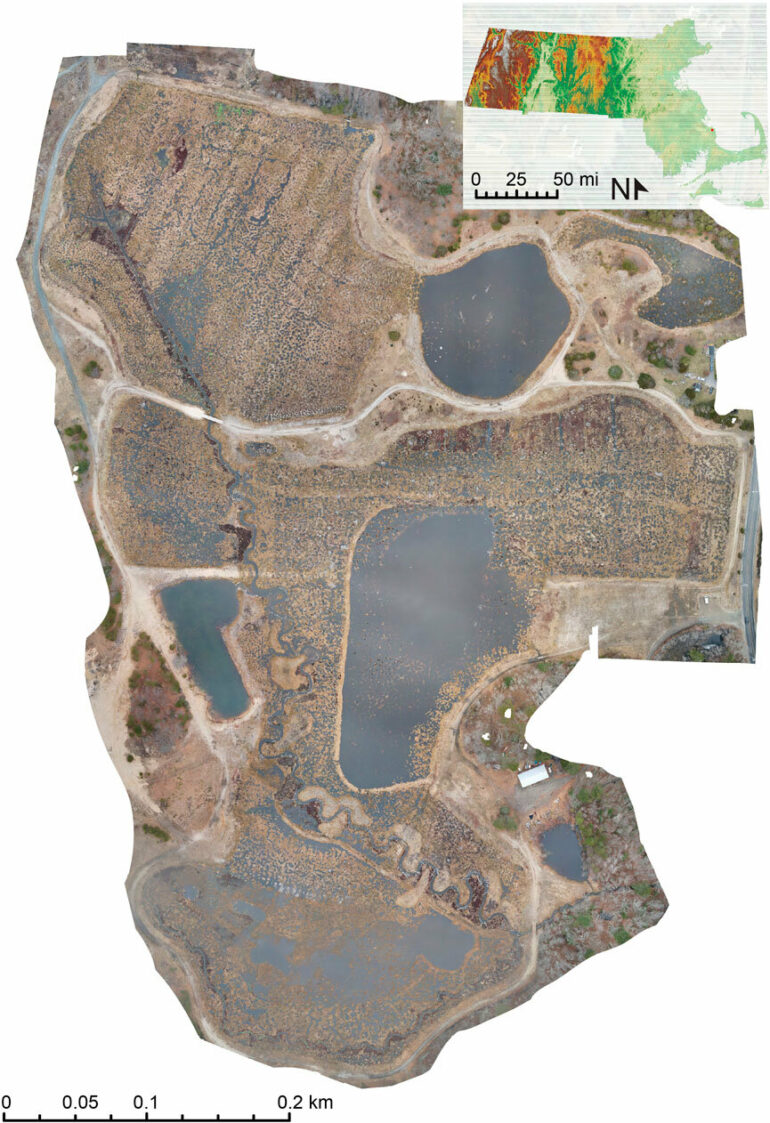Using a first-of-its-kind approach that entailed drones and infrared imagery, researchers from the University of Massachusetts Amherst investigated a series of former commercial cranberry bogs in eastern Massachusetts that are being restored. The team not only demonstrated how to best restore freshwater wetlands, but also showed that these wetlands are operating as self-sustaining ecosystems. The work was recently published in a pair of papers in a special issue of the journal Frontiers in Earth Science.
For generations, eastern Massachusetts has been the cradle of cranberry production in the United States, and currently has more than 14,000 acres under cultivation. Cranberries thrive in acidic peat bogs, which are the legacy of the last ice age. When Euro-Americans began commercially cultivating cranberries in the mid-1800s, they did so by drastically altering the natural freshwater wetlands in order to improve yields.
“Instead of thick masses of peat,” says Christine Hatch, extension professor of earth, geographic and climate sciences at UMass Amherst, lead author of the paper on recovering groundwater and a member of the commonwealth’s Water Resources Commission, “these human-altered cranberry bogs look like a Kit Kat bar when you dig down into them.”
That’s because chocolate-colored layers of peat are interspersed with wafer-colored layers of sand. Whereas peat acts like a sponge, soaking up and holding groundwater, the sand, deposited in inch-thick layers by cranberry farmers every few years over the past 15 decades, acts like a drain and can help get rid of excess water, as well as increase yields and suppress weeds and pests.
Such sand-filled bogs, which the authors call “anthropogenic aquifers,” perform very differently from natural ones. As small family-run cranberry bogs cease production, the question has arisen, what to do with them? One answer: return the bogs to their natural state—which is exactly what the state of Massachusetts is doing.
“Massachusetts has recognized that wetlands are incredibly important resources,” says Hatch. “They’re the most biodiverse ecosystems we have. And they perform all sorts of ecosystem services, from managing floodwaters, to storing carbon and purifying drinking water. They’re also fantastic sites for recreation. The state has committed generous resources to restore these wetlands, which makes me proud to live in Massachusetts.”
How to restore a wetland
Though Hatch notes that it’s easier to restore what was once a wetland than to create a new one from scratch, it is still quite a complicated task to undo 150 years of landscaping. water moved through the old, peat-filled bogs incredibly slowly, it courses much more rapidly through the human-made anthropogenic aquifers, draining off and ultimately disappearing from the wetland ecosystem. Restoring the wetland means returning the groundwater to its slow pre-agricultural rate of flow and holding on to that water.
It’s not enough to simply pull out all the drainage pipes and fill the ditches that farmers have laid and dug over the generations. “You have to deal with all that sand,” says Hatch. “In the perfect scenario, we’d dig it all out, down to the untouched deposits of solid peat,” she continues, “but that’s cost-prohibitive and risks disturbing decades’ worth of pesticides that growers have sprayed over their bogs.”
Hatch and her colleagues conducted their research at two sites near Plymouth, where they cored the soil, collected water samples, monitored the location of the groundwater and the speed at which it moved and measured water temperatures and levels. Armed with this data, they discovered that it’s not necessary to remove the sand from the bog for it to return to its pre-agricultural state. It’s only necessary to move it around, mixing it into the layers of peat, enough. But how much is enough?
Mapping success
The answer to that question hinges on how much and how slowly groundwater moves through the bog. In order to track the and measure the movement of groundwater, Hatch and her graduate student, Lyn Watts, lead author of the paper on mapping groundwater, as well as co-author Ryan Wicks, of UMass Amherst’s UMassAir, took to the air during the pre-dawn hours in the dead of winter during 2020 and 2021.
Watts, an ace drone pilot, flew a UAV equipped with an infrared camera capable of seeing heat. Since groundwater remains at a nearly constant temperature year-round, she was able to “see” how the groundwater, which was warmer than the frozen surface water, moved through the former cranberry bogs, and to map its flow across the entire system of wetlands at the study sites.
What Watts discovered was that the groundwater was spending more time moving through the restored bog, just as it would in its pre-agricultural state, and that this increased residence time allowed the bog to “fill up” with enough water for it to pool at the surface.
“We show that, at these restored bogs, groundwater is remaining in the area, not moving off of it,” says Watts. “This means that restoration is successful, and the bogs will quickly return to self-sustaining ecosystems.”
Looking beyond Massachusetts
Because the geology of eastern Massachusetts is similar to that throughout much of the Northeastern U.S., Hatch and Watts’s work is broadly applicable. “Our research can help restoration designers and engineers to more deliberately plan their efforts,” says Watts.
“Restoring buried wetlands to their previous ecological glory has a very high success rate,” says Hatch. “That success depends on getting groundwater to stay in the system. We’ve shown how to do that, and our research can help us conserve one of our most treasured ecosystems.”
More information:
C. Lyn Watts et al, Mapping groundwater discharge seeps by thermal UAS imaging on a wetland restoration site, Frontiers in Environmental Science (2023). DOI: 10.3389/fenvs.2022.946565
Provided by
University of Massachusetts Amherst
Citation:
How to re-wild a wetland: Focus on the groundwater (2023, February 6)



